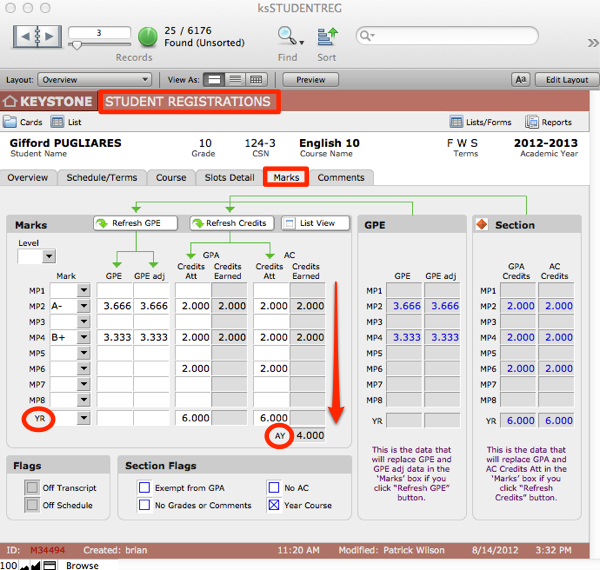Some words used by schools have multiple meanings. Where possible, we attempt to use terminology consistently in KEYSTONE. Nonetheless, it would be awkward and somewhat artificial to ignore common usage even though it may be confusing. The most common multiple meaning words are explained below.
Class
Our primary use of the word “class” in KEYSTONE is the joining of grade and a section. For example, “The student is in the 1B class.” Generally, the word “class” does get confused with both section and course in common speech. For example, a student would say, “I am taking a Spanish class.” In KEYSTONE however, we prefer the term “course” instead of “class” for this usage. Instead of a teacher teaching three different classes of Spanish this term, we prefer to say that the teacher is teaching three sections of Spanish 2 this term.
Class List
This could either be a list of the ninth graders, or a list of the students in Mr. Garcia’s Algebra II section. We prefer to use the term “class roster” for a list of the students in an academic section, such as Mr. Garcia’s Algebra II section. A class list then, would show all the students in 2B or section B of the second grade.
Grades vs. Marks
Our primary use of the word “grade” in KEYSTONE is a child’s enrollment level, such as 4th grade or 10th grade. However, one cannot avoid the use of “grade” as in “his final exam grade was a B+.” Where possible, we prefer to use the term “mark” for the evaluation number or letter given by a teacher instead of “grade”. One exception is our use of “grade reporting and comments”, conforming to the term used by most educators.
Marking Periods (MP) vs. Terms
A marking period is a part of the academic year between two dates, at the end of which an evaluation number or letter or comment is given by the teacher to each student. There may be multiple marking periods within a Term.
If the academic year is organized into semesters, it will have two terms; if trimesters, it will have three terms (usually Fall, Winter and Spring terms). Often, marks will be issued for interim and then final marking periods for each term. The overall Final marks for the full year would be considered an additional marking period.
Course vs. Section
A course may be offered year-after-year, such as Chemistry. The word “section” is deliberately used in two different ways to match current convention. The 40 or so students taking Chemistry may be broken into three “sections” in a particular acacemic year. Here “section” is an offering of a course by a specific teacher, in a specific room, in a specific term. In addition, Kindergarten grade may be divided into sub-groups—Section A, Section B and Section C. In this case, KB is a class—one of the three sections of the Kindergarten grade.
AY vs. YR
…in ksSTUDENTREG
Within a ksSTUDENTREG record > Marks tab, you will see eight rows labeled MP (marking period) and also one marked YR. In this instance, YR is equivalent to a ninth marking period; that is, a school may award a final grade for the year that is entered separately.
In a ksSTUDENTREG record, AY shows the cumulative Academic Credits earned by that Student for that Section for all the MPs for that AY.

…in ksENROLLMENT
Within a ksENROLLMENT record > GPAs tab, you will see a compilation of data for one Student for all Sections taken for all MPs over the entire Academic Year.

GPA Credits vs. Academic Credits
GPA Credits are used to calculate GPAs. Academic Credits (AC) are used to calculate the credits toward graduation, the credits that will appear on the transcript. Some schools track these separately.
